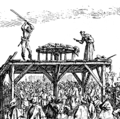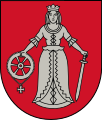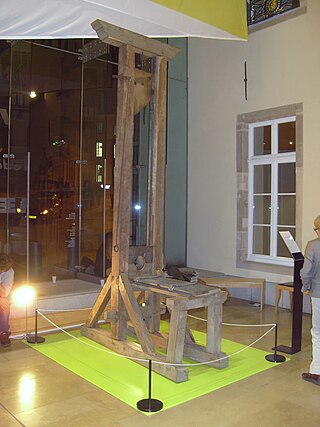
A guillotine is an apparatus designed for effectively carrying out executions by beheading. The device consists of a tall, upright frame with a weighted and angled blade suspended at the top. The condemned person is secured with a pillory at the bottom of the frame, holding the position of the neck directly below the blade. The blade is then released, swiftly and forcefully decapitating the victim with a single, clean pass; the head falls into a basket or other receptacle below.

Decapitation is the total separation of the head from the body. Such an injury is inevitably fatal to humans and most other animals, since it deprives the brain of oxygenated blood, while all other organs are deprived of the involuntary functions that are needed for the body to function.
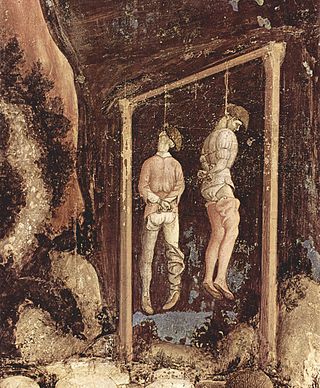
Hanging is killing a person by suspending them from the neck with a noose or ligature. Hanging has been a common method of capital punishment since the Middle Ages, and is the primary execution method in numerous countries and regions. The first known account of execution by hanging is in Homer's Odyssey. Hanging is also a method of suicide.
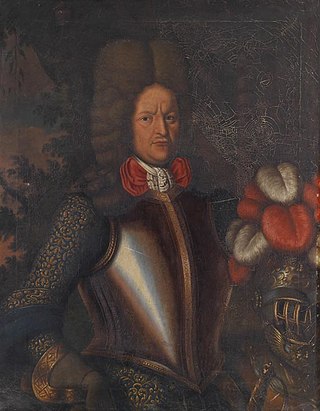
Johann Reinhold Patkul was a Livonian nobleman, politician and agitator of Baltic German extraction. Born as a subject to the Swedish Crown, he protested against the manner of King Charles XI of Sweden's reduction in Livonia, enraging the king, who had him arrested and sentenced to mutilation and death (1694). Patkul fled from the Swedish Empire to continental Europe, and played a key role in the secret diplomacy (1698-1699) allying Peter I of Russia, Augustus II the Strong of Saxony and the Poland–Lithuania - as well as Christian V and his successor Frederick IV of Denmark–Norway - against Charles XII of Sweden, triggering the Great Northern War of 1700-1721. Patkul was close friends with the Danish Privy Councillor Knud Thott who had been driven away from his home province Scania during the Scanian War. During the 1690s and early 1700s the two of them worked actively for Danish intervention against Sweden so that Livonia and Scania might be freed from Swedish overlordship. During the first war years, Patkul retained a key role in the communication between the allies and other European courts, holding positions at king Augustus's court first in Augustus's interests (1698-1700), then in tsar Peter's service. In late 1705 Patkul fell from Augustus's favor and was arrested and charged with high treason. Throughout the following year he was detained first in Sonnenstein, then in Königstein, before Charles XII forced Augustus to extradite him by the Treaty of Altranstädt in late 1706. Patkul spent another year in Swedish detention before Charles XII had him broken on the wheel and decapitated.

Execution by elephant was a method of capital punishment in South and Southeast Asia, particularly in India, where Asian elephants were used to crush, dismember, or torture captives during public executions. The animals were trained to kill victims immediately or to torture them slowly over a prolonged period. Most commonly employed by royalty, the elephants were used to signify both the ruler's power of life and death over his subjects and his ability to control wild animals.

Albert Pierrepoint was an English hangman who executed between 435 and 600 people in a 25-year career that ended in 1956. His father Henry and uncle Thomas were official hangmen before him.

An executioner, also known as a hangman or headsman, is an official who effects a sentence of capital punishment on a condemned person.

Capital punishment is a legal penalty in the U.S. state of Ohio, although all executions have been suspended indefinitely by Governor Mike DeWine until a replacement for lethal injection is chosen by the Ohio General Assembly. The last execution in the state was in July 2018, when Robert J. Van Hook was executed via lethal injection for murder.

Dismemberment is the act of completely disconnecting and or removing the limbs from a living or dead being. It has been practiced upon human beings as a form of capital punishment, especially in connection with regicide, but can occur as a result of a traumatic accident, or in connection with murder, suicide, or cannibalism. As opposed to surgical amputation of limbs, dismemberment is often fatal. In criminology, a distinction is made between offensive dismemberment, in which dismemberment is the primary objective of the dismemberer, and defensive dismemberment, in which the motivation is to destroy evidence.
Capital punishment in Canada dates back to Canada's earliest history, including its period as a French colony and, after 1763, its time as a British colony. From 1867 to the elimination of the death penalty for murder on July 26, 1976, 1,481 people had been sentenced to death, and 710 had been executed. Of those executed, 697 were men and 13 women. The only method used in Canada for capital punishment of civilians after the end of the French regime was hanging. The last execution in Canada was the double hanging of Arthur Lucas and Ronald Turpin on December 11, 1962, at Toronto's Don Jail. The National Defence Act prescribed the death penalty for certain military offences until 1999, although no military executions had been carried out since 1946.

Capital punishment is a legal penalty in Belarus. At least one execution was carried out in the country in 2022.

Capital punishment in France is banned by Article 66-1 of the Constitution of the French Republic, voted as a constitutional amendment by the Congress of the French Parliament on 19 February 2007 and simply stating "No one can be sentenced to the death penalty". The death penalty was already declared illegal on 9 October 1981 when President François Mitterrand signed a law prohibiting the judicial system from using it and commuting the sentences of the seven people on death row to life imprisonment. The last execution took place by guillotine, being the main legal method since the French Revolution; Hamida Djandoubi, a Tunisian citizen convicted of torture and murder on French soil, was put to death in September 1977 in Marseille.

Capital punishment in Germany has been abolished for all crimes, and is now explicitly prohibited by the constitution. It was abolished in West Germany in 1949, in the Saarland in 1956, and East Germany in 1987. The last person executed in Germany was the East German Werner Teske, who was executed at Leipzig Prison in 1981.
Capital punishment is forbidden in Switzerland under article 10, paragraph 1 of the Swiss Federal Constitution. Capital punishment was abolished from federal criminal law in 1942, but remained available in military criminal law until 1992. The last actual executions in Switzerland took place during World War II.
Capital punishment in Saudi Arabia is a legal punishment, with most executions in the country being carried out by decapitation (beheading) – Saudi Arabia being the only country in the world to still use the method. In 2022, recorded executions in Saudi Arabia reached 196, the highest number recorded in the country for any year over the last three decades.

The 1978 Spanish Constitution bans capital punishment in Spain, except for wartime offences. Spain completely abolished capital punishment for all offenses, including in times of war, in October 1995.

Hans Erwin Hagedorn was an East German serial killer who murdered three young boys from 1969 until 1971.
Criminal justice in New France was integral to the successful establishment of a French colonial system in North America. New France was no stranger to criminal activity from its very roots. In 1608, shortly after the founding of Quebec, Samuel de Champlain executed Jean Duvel for allegedly leading a conspiracy against him. By 1636, the citizens of Québec began to be charged for crimes such as blasphemy, drunkenness and failing to attend Mass. As New France progressed, its legal institutions became more advanced. Promulgated across the France and the French Empire in 1670, the Criminal Ordinance of 1670 provided a foundation for New France's criminal procedures and punishments.

At the lot Galgenbihl, a former place of executions in Bregenz was the location where in earlier times people of Vorarlberg, Austria, convicted in the County of Bregenz, were executed. Synonyms in German to name such a place are e.g. Richtstätte, Richtplatz and Richtstatt, all words implying a place combined with judgement, in German: richten.











